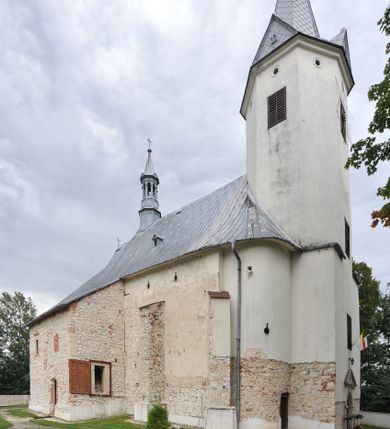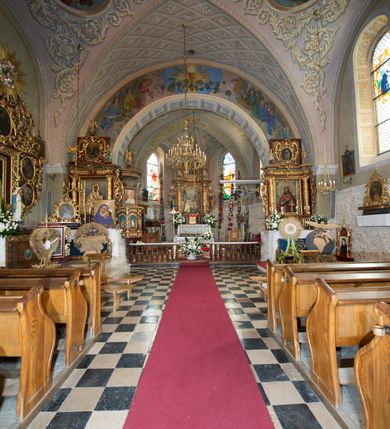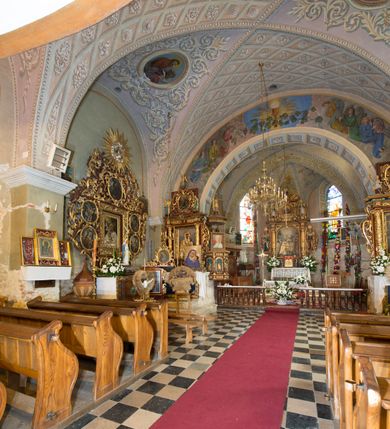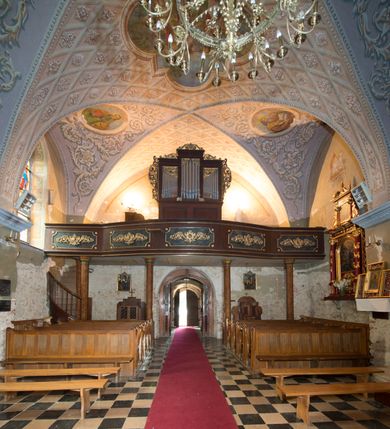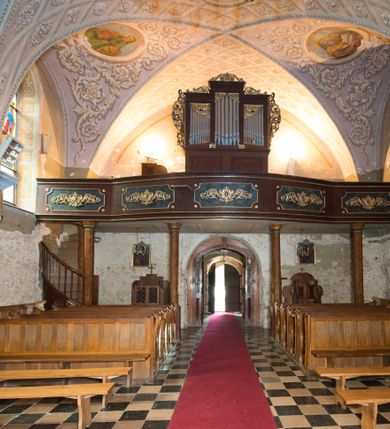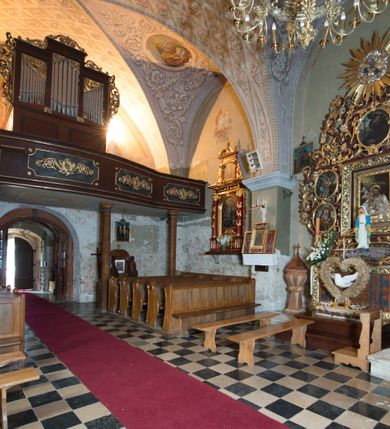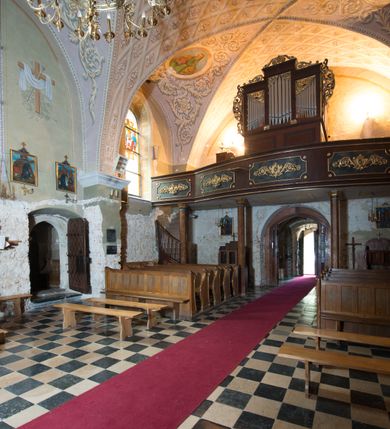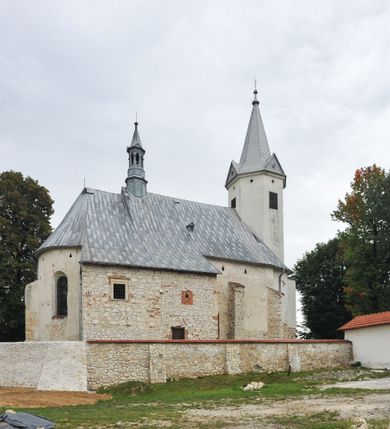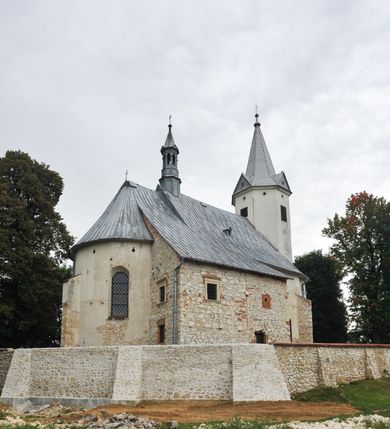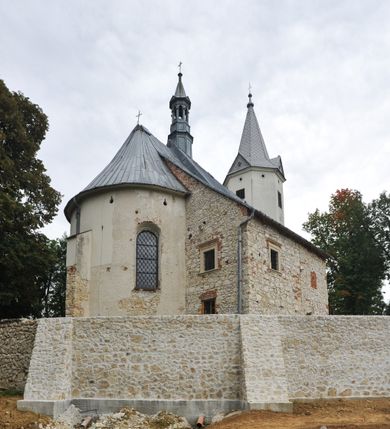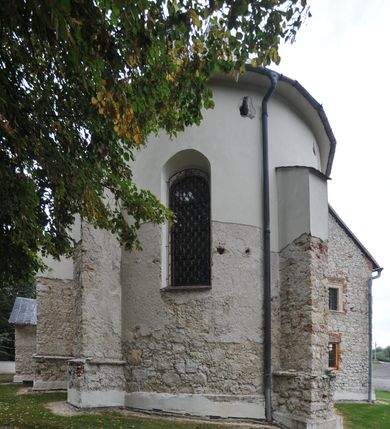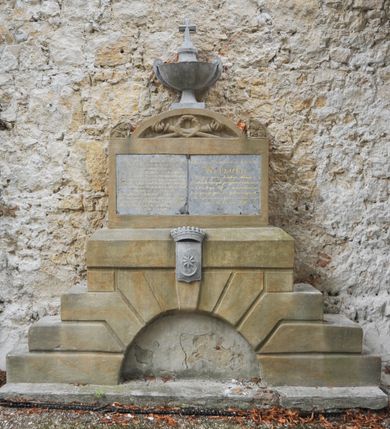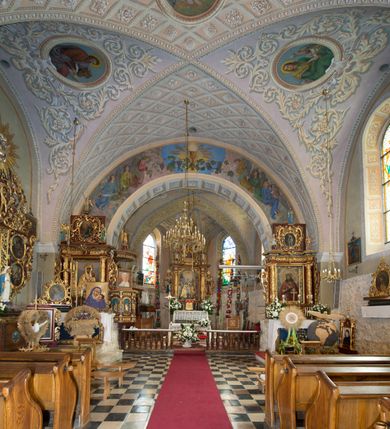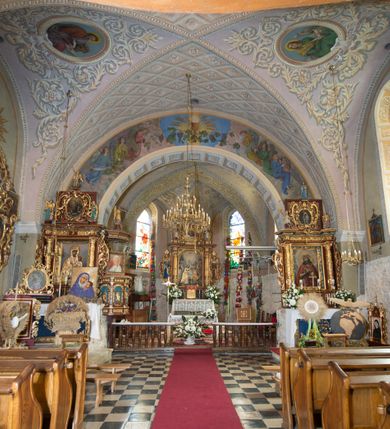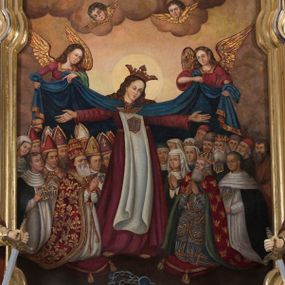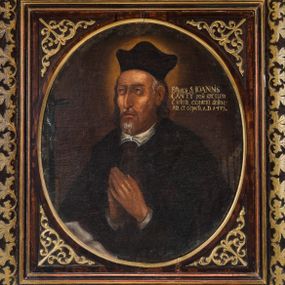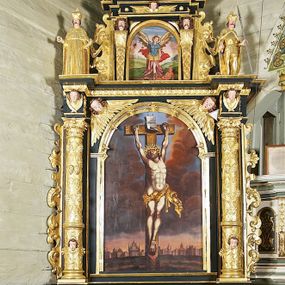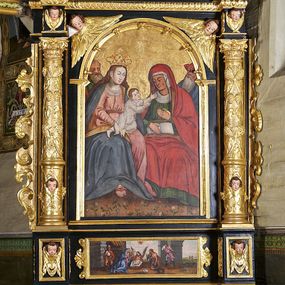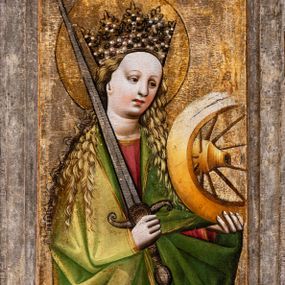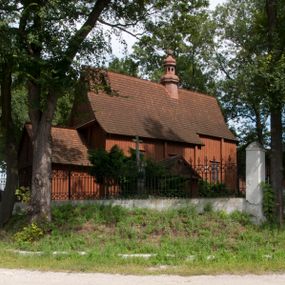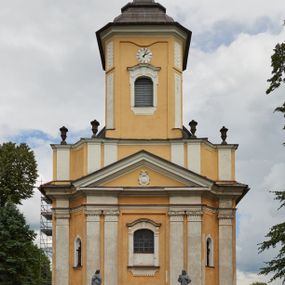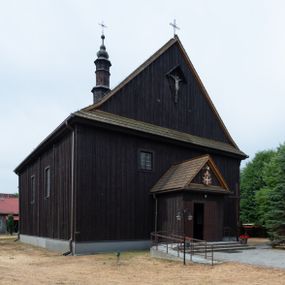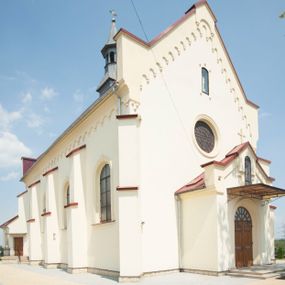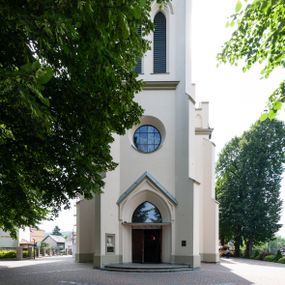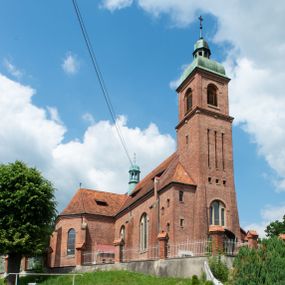
Church of the Nativity of St. John the Baptist in Korzkiew
Place
Korzkiew
Parish
Nativity of Saint John the Baptist parish in Korzkiew
Identifier
DZIELO/14511
Amount
1
Catalogue note author
Maria Działo
History of work
The parish in Korzkiew was established in the second half of the 14th century. The first mention of the construction of a wooden temple comes from 1445. The preserved Gothic reliquary probably dates back to that period and contains, according to the inscription, relics of the True Cross and the table from the Cenacle. During the oldest known visitation of the Skalski deanery in 1598, the old church was described as timeworn and abandoned "Ecclesia Parochialis lignea ruinosa et deserta tituli S. Joannis Baptiste a multis annis vaccat [...]". In the following visitations in 1610 and 1618, the only additional information was that there was an "old" wooden church in Korzkiew. In the years 1620–1630, a new brick church was built by the owner of the village, Aleksander Ługowski (1589–1651). The new church was first mentioned in the episcopal visitation in 1630, with the notation that it was built over the last ten years and is not yet equipped with altars "Villa Korzkiew. Ecclesiam habuit antea annus ligneam in priori riptonem locus tantum ostensus fiut: Nunc a decem annis Gnessus Dnum Alexander Ługowski villi haeres eandem in alio loco a diverse recipit, etiam finissit totamque ecclesiam testudine clausit. [...] Intus nondum sunt altaria erecta.” The triangular pediment above the entrance to the church includes a cartouche with the coats of arms of Aleksander Ługowski and the date 1623, which some researchers associate with the date of the church's foundation. However, the episcopal visitation in 1630 clearly stated that the church had been built over the last decade. It is possible that the date on the pediment was distorted from 1629 to 1623 during one of the previous conservation works. The year 1629 could be when the construction has been completed. There were also many other, less probable hypotheses, for instance that the date 1623 refers to the acquisition of the Korzkiew estate by the Ługowski family or that the portal was transferred from the castle. The church was consecrated by the Laocydean bishop, Cracow suffragan Tomasz Oborski on 23 September 1640, dedicated to Saint John the Baptist. This dedication was clarified at the beginning of the 20th century, by adding "Nativity" of St. John the Baptist. In 1642, a small, wooden chapel of the Transfiguration of Jesus, located by the cemetery, was consecrated. Later, the altar was moved from the chapel to the church, where it remained to this today. In the next episcopal visitation from 1727, the interior of the temple was described and its main furnishings were listed, including the pulpit, the choir-stalls, and four altars: the high altar of St. John the Baptist, the altar of Jesus Christ, the altar of Virgin Mary and the altar of St. Joseph. On the other hand, in the visitation from 1784, information can be found also on other interior decoration of the temple, namely, the figure of Christ Crucified, which was located on the chancel arcade "In medio Ecclesia intrando alias majorem Chorus, est arcus alias Tencza, in qua Figura Passionis Domini conspicitur”. In the inventory from 1791, four altars are still listed, therefore, the last, fifth one from the chapel of Transfiguration of Jesus must have been transferred to the church much later, but before 1828 (since that year it has appeared in church inventories). In the 19th century, the state of preservation of the church was very poor, as evidenced by the correspondence of the parish priest and the general consistory, as well as the record in the church inventory from 1844 "near the large altar, there are cracks of considerable length in the wall that pose a real threat of collapse of these walls, and from the side of village Brzezawka, similar ones running from the ceiling down to the foundations". Although most researchers attribute the poor state of preservation of the church exclusively to the fires of 1853 and 1858, Piotr Szlezynger adds a few more important aspects to the issue, including "the lack of ongoing repairs and the destructive effects of natural factors such as water and wind". Subsequent parish priests unsuccessfully demanded that the church be repaired by local landowners. Finally, on 15 June 1853, the parish priest, after consulting the builder of Olkusz poviat, requested the general consistory to close the church because of the copings which threatened to collapse. The decision was executed in July of the same year. The event caused numerous protests among the inhabitants, as well as a declaration of the then owner of the estate, Józef Sedlmajer, that he would renovate the temple. The governorate authorities commissioned an additional assessment to architect Felicjan Frankowski (1802-1865), who stated that the temple was in bad condition, but was not threatened by the collapse of the copings. In view of this assessment, the authorities allowed the church to be reopened, which took place in February 1854. The church was renovated in 1855-1858 according to the design of Frankowski: the roofs were repaired, the tower was rebuilt, a new Gothic cupola and a ridge turret were added, the whole building was plastered, new doors and windows, as well as bars and brick fences were made. The marble floor arranged in a black and white checkerboard dates back to 1869.
Abstract
The Church of the Nativity of St. John the Baptist in Korzkiew was built in the years 1620-1630 from the foundation of the owner of the village - Aleksander Ługowski (1589-1651). In the triangular pediment above the entrance to the church there is a cartouche with the coat of arms of the funder and the date 1623, which some researchers identify with the date of the church's creation. The church was consecrated by the Laocydean bishop, Cracow suffragan Tomasz Oborski on 23 September 1640, dedicated to Saint John the Baptist. This dedication was clarified at the beginning of the 20th century, by adding "Nativity" of St. John the Baptist. In 1642, a small, wooden Transfiguration Chapel, located at the cemetery, was consecrated. After it was demolished, the altar was moved to the church, where it is until today.
The church in Korzkiew is an example of the slow transformation of religious architecture from Gothic to Renaissance. The great role of Ługowski in shaping the appearance of the temple is emphasised by the rich decoration and a coats of arms in places related to the funder, i.e. the high altar or entrance portal. Above all, however, the role of Ługowski as a funder is emphasised by the matroneum at the chancel, which in the 17th century was already a significant anachronism in church architecture (at that time, the funders usually occupied a place in choir-stalls). The Korzkiew matroneum emphasised the patronage of the magnate, its funders and their legal successors used it. The genesis of the entire temple is also medieval with the influence of renaissance and mannerist forms. It is interesting because at about the same time, buildings in the spirit of mature Baroque were already erected, e.g. the Church of the Holy Sepulchre in Kalwaria Zebrzydowska from 1611-1615. Piotr Szlezynger during his research on the church in Korzkiew discovered a number of walled shooting niches in the attic. This discovery led to the thesis that, apart from the sacral function, the temple also had a defensive function with a shooting porch above the vault. Therefore, the temple was located on a hill for a defensive purpose, in a naturally inaccessible place, 13 meters above the Korzkiew castle. The funder's intention was that the castle and church (only 200 meters apart) were supposed to have defensive features supporting each other. The church's "modern elements" include a semi-circularly closed chancel, cross-barrel vault, and architectural detail, i.e. rusticated portal with a triangular pediment. The tower is covered with a tented roof crowned with triangular flèches, but it is a later, neo-gothic addition from 1858.
Although the church looks quite barren from the outside, without architectural divisions, flanked only by buttresses fastening the walls of the building, it is decorated inside with a picturesque decor with most of wood carving works from the Mannerist era. The temple has a pulpit and four altars from the second quarter of the 17th century and one altar from around the mid-17th century. The stained glass windows were made in the 1940s, probably at the Paczków brothers' factory in Podgórze in Cracow. In the church, there are also: a stone baptismal font and a stoup from the first half of the 17th century, two crucifixes from the 17th century, as well as a number of monuments from the second half of the 17th century, i.e. organs, confessional, two procession floats, internal doors with iron, horizontal slats and presenter's pew. The choir supported on four pillars was made in 1855-1858. On the high altar there are two 16th-century herm-shaped reliquaries, which repeat the conventions of gothic herms, known from the Church of Saint Giles in Cracow. A small bell is hung on the church tower, cast in 1520 and re-cast in 1611 from the foundation of Stanisław Ługowski, as well as two newer ones cast in 1884. From the gothic furnishings of the previous temple, a reliquary has survived, which, according to the inscription, contains relics of the Holy Cross Tree and the table from the Cenacle. In addition, some valuable paraments from the church in Korzkiew are exhibited at the Archdiocese Museum in Cracow. It is interesting that near the church in the first half of the 18th century a treasure was found, consisting of Roman denarii from the 1st or 2nd century, which was embedded in a silver mug, a product of the Cracow goldsmith Józef Ceypler (1709-1745). Currently the mug is in the National Museum in Poznań. Its origin is evidenced by the inscription "A strong plowman plowing the field in Korzkiew plowed this wealth, from which the jug is made. Old Fortune, I will drink you from a full jug now, not sought for a long time, although you come to me for a long time".
Other works from this place
Similar works
How to cite?
Maria Działo, "Church of the Nativity of St. John the Baptist in Korzkiew", [in:] "The Sacred Lesser Poland Heritage", 2026, source: https://sdm.upjp2.edu.pl/en/works/church-of-the-nativity-of-st-john-the-baptist-in-korzkiew
